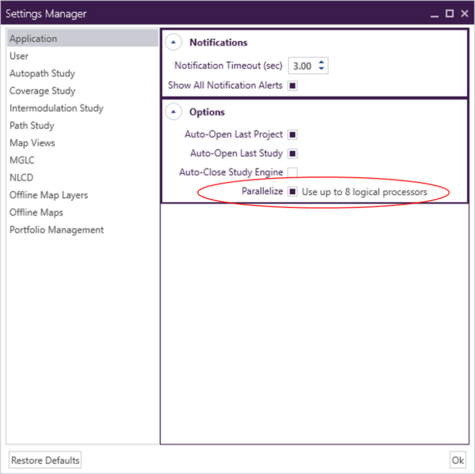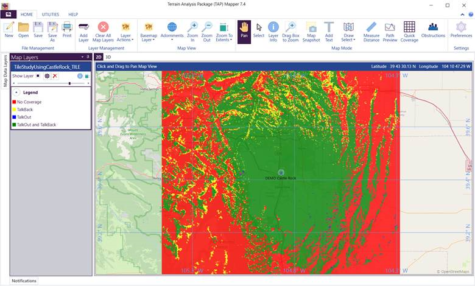We are pleased to announce that we have released Terrain Analysis Package (TAP™) 7.4. The highlights of this new version include:
- Parallel Multi-Core Processing: TAP 7.4 can reduce the computation time for large coverage studies by using multi-core parallel processing. This feature is available to users with maintenance expiration dates of June 1, 2020 or later.
- Concurrent TalkBack Coverage Calculation: TAP 7.4 can concurrently calculate both TalkOut and TalkBack coverage, including with different transmitter and receiver antennas, rather than requiring a TalkBack post-processing step.
Click here to view a TAP 7.4 tutorial video.
parallel multi-core coverage study processing
In recent years, the time to calculate results for large coverage studies has been dramatically reduced, owing to advances in computer processing hardware and memory access. Given the proliferation of high-speed solid state data storage, it is now possible to reduce the calculation time even more by utilizing multiple cores for parallel processing. Multi-core parallel processing is effective only when topographical and any land cover data are stored on (internal or external) solid state drives. If topo and land cover data are stored on traditional rotating hard drives then parallel multi-core processing will increase study calculation times.
Users with SSD data storage and maintenance date of June 1, 2020 or later can click on the Settings Manager gear icon in the main ribbon bar. Navigate to the Application settings and check the box to ‘Parallelize’. If the study server is already running, it must be closed for this change to take effect. SoftWright benchmark experiments have shown coverage study run times can be reduced by a factor of two to four times by enabling parallel processing; the degree of improvement will depend on the user hardware.

concurrent talkback coverage calculation
Until the new 7.4 release, TAP coverage studies calculated TalkOut coverage in the Fixed Facility to Mobile Facility link direction. Subsequently, TalkBack coverage from the Mobile Facility to the Fixed Facility could be calculated as a post-processing step, under the assumption of a reciprocal link (i.e., the same propagation model losses in both directions). This assumption held well for transmitter and receiver antennas with the same gain patterns and centers of radiation, and closely spaced transmit and receive frequency pairs, but often required a second set of coverage studies to model more complex configurations. With the expansion of receive-only (e.g., Voting) systems and RF configurations utilizing different transmit and receive antennas and heights, SoftWright prioritized the implementation of concurrent TalkBack to greatly facilitate the evaluation of coverage for receive-only sites and TalkBack coverage from sites with disparate transmit and receive characteristics.
TAP 7.4 provides concurrent calculation of both TalkOut and TalkBack coverage even for systems with different transmit and receive antenna heights. This new feature is available to all TAP 7 users regardless of maintenance subscription status. The coverage study output, shown below, now includes a Coverage field, which will indicate areas with TalkOut coverage, TalkBack coverage, and both TalkOut and TalkBack coverage as applicable. The TalkOut fields in the coverage study output are unchanged, but there are now additional, corresponding TalkBack fields in the coverage study output shapefile, each beginning with ‘Tb.’

